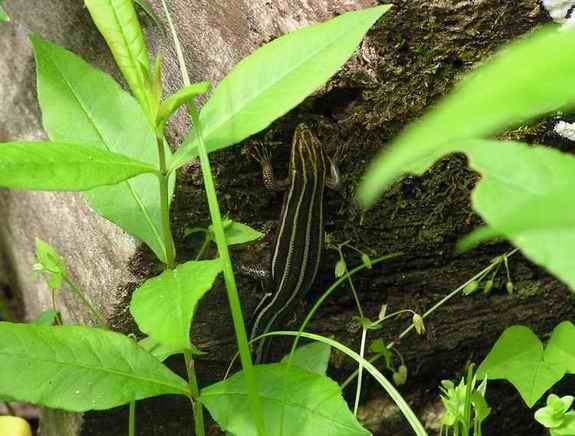|
Return to Hiker's Notebook Home Page
Common Name: Five-lined Skink, Blue-tailed Skink, Red-headed Skink - Skink is derived from the Greek word for lizard, skinkos; five-lined refers to the distinctive linear dorsal markings of this species of skink.
Scientific Name: Eumeces fasciatus - The generic name is from the Greek words eu meaning "true" and mekos meaning "length", referring to the long tail of the skink. The species name comes from fascia, the Latin word for band in reference to the dorsal lines.
Skinks are members of the family Scinidae (from scincus, the Latin derivative of the Greek skinkos, also meaning lizard) which is the largest of the lizard families with 87 genera and over 1200 species on every continent except Antarctica; North America has three genera and fifteen species; most skink species are found in South and Southeast Asia. Though there is some confusion and disagreement about the specifics of taxonomic classification within the family, skinks are generally characterized by two overarching physical features. They are covered with smooth, flat, overlapping scales that impart a streamlined appearance; each scale has a bony plate called an osteoderm. They are also generally characterized as lacking a definitive neck and having short legs; several species have no legs or much reduced legs and therefore must employ snake-like undulations for locomotion. According to folklore wisdom, some skinks are poisonous and are even called scorpions to reflect this association. In reality, skinks are not poisonous and will only bite if provoked; the bite of smaller skinks like the Five-lined Skink is not painful and not likely to break the skin.
The skinks of the genus Eumeces are differentiated from other skinks of the Scinidae family in having several distinctive characteristics. Their conical teeth are consolidated with the mouth ridge without sockets, an arrangement known as pleurodont. They have eyelids that are scaly relative to the smooth eyelids of other skinks. However, their eyelids lack a partially transparent disk found on other skinks, a feature that allows for vision through the eyelid when it is closed so as to prevent the entry of dirt. Lastly, they have unique separated pterygoid and palatine bone structures in their mouths.
One curious feature that species of the genus Eumeces share with several other skink species is a fracture plane at the base of the tail. This structure evolved so that the tail could easily be removed without significant damage to the skink, an instance of autotomy, the reflex separation of a part or limb from the main body trunk. The facilitated and voluntary shedding of the tail enables the skink to escape the assault of a predator, most typically grabbing the nearest and most obvious part of the rapidly retreating lizard. The predator is left with a thrashing and twitching appendage while the skink, now tailless, has escaped under the nearest rock. To accentuate the attractiveness of the tail to predators, it is bright blue in color on many skinks. For the Five-lined Skink, the tail is only blue in the juvenile stage, when the lizard is most vulnerable to predation, turning brown to match the body as the animal matures. The common name of Blue-tailed Skink establishes the cultural notoriety of this adaptation. When the tail is lost, the skink regenerates a new tail, which is known to biologists as an autotomized tail. It is shorter in length than the original tail and is supported by a cartilaginous frame in lieu of the osteal vertebrate structure of the original tail.
During the spring breeding season, the male Five-lined skink affects a color change in which the snout turns orange-red, perhaps as a visual cue to attract females. The common name Red-headed skink is attributable to this affectation. Skinks are very territorial in their home ranges that are roughly thirty meters in diameter. The male defends against intruding males while seeking to attract females with a relatively complex courtship behavior. Since larger female skinks can lay more eggs, the males will fight each other with ferocity for procreation rights in their case. On attracting a willing and preferably large female, the male approaches from the side, grasps the female's neck and engages in copulation that lasts about five minutes.
Skinks are oviparous, they lay ten to twenty eggs in late spring; four to six weeks are necessary for the eggs to incubate and hatch. The female skink is a surprisingly diligent guardian, brooding over the nest to protect the eggs from predation and deleterious environmental conditions. To maintain the proper humidity for egg incubation, the female will cover the eggs when the soil is dry to reduce evaporation and will urinate on the eggs to hydrate them. To maintain the proper temperature for embryo development, female skinks will bask in the sun to absorb radiant energy and then return to the nest to transfer the heat to the eggs. Rotten eggs are eaten by the female for nutrition; displaced eggs are returned to the nest by rolling them back in with the snout. Due to the long duration and due diligence of the incubation period, female skinks will form communal groups to share the duties of caring and nurturing of the eggs. |
